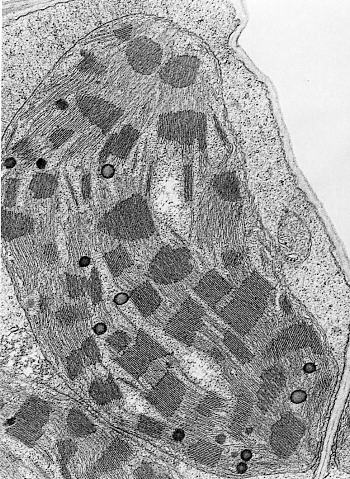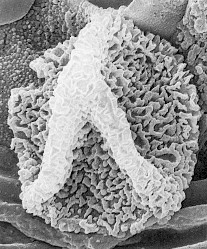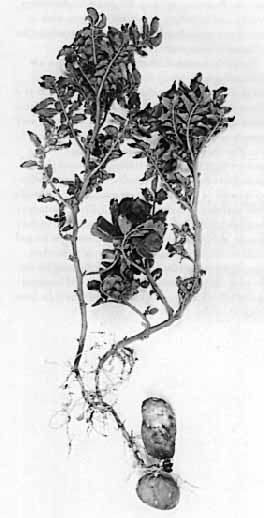
Botany for the Next Millennium:
Our lack of understanding when it comes to plants and ecosystem workings shows up in the steady flow of news about environmental crises. Red or brown "tides" of marine algae appear along the Atlantic coast and fish die off. Wildfires engulf Yellowstone National Park or the California hills, destroying forests and homes. Kudzu (Pueraria lobata), purple loosestrife (Lythrum salicaria), water hyacinth (Eichhornia crassipes), and other invasive plants threaten the south, the Everglades, our national parks. Very little of the natural world remains pristine; most of it is now managed. Yet the management proceeds without a sound understanding of ecosystems, often leading to crises. Some of the toxin-producing algae responsible for the fish kills were unknown to science before they bloomed, a phenomenon that seems to be Increasing worldwide. The biological necessity of fire for some ecological communities remains hard for the public to fathom and to apply. And how an apparently innocuous plant can suddenly turn into a multimillion dollar problem weed continues to perplex plant biologists.
Conversely, what we have learned from plant studies has engendered a wealth of tangible practical results, and not just in terms of foods. Plants enter our lives in innumerable ways, a function of their genetic, chemical, and structural diversity. You are looking at a plant product in the form of this page. (Despite the proliferation of electronic communication, readers still prefer the texture and eye-ease of printed paper.) You are also probably wearing plant products in the form of cotton, linen, or rayon, and sitting on or in a structure of wood, perhaps the most prized of plant products. No matter what you last ate, the fuel it is providing your cells to function was originally captured from the sun by a carbohydrate-making plant The spice, color, or flavor of the food no doubt cam from a plant leaf, seed, or oil.
Plant products similarly form the basis of many common, and many unusual, medicines. Long before, Bayer chemists commercially synthesized salicylic acid, the
 |
|---|
| Electron micrograph of a chloroplast in a leaf cell of Zea mays. Courtesy: Ray F. Evert. |
Several specialties within botany are devoted to understanding the biochemistry and molecular biology of these compounds, and why there is so much chemical variation among plants. Most of these compounds, once thought to be waste products, are now believed to be chemical defenses against herbivore or attractants for pollinators, although the specific function has been demonstrated for few cases. The presence of chloroplasts in plant cells explains some of the most vital (and valuable) plant chemistry. These organelles are the site of photosynthesis and the manufacture of the eight or more amino acids we call essential, because we cannot make them but need them in our diets to build proteins. The creative capabilities of chloroplasts hark back to their origins as bacterial cells, which were engulfed or otherwise entered into a symbiotic relationship with larger cells, leading to the evolution of photosynthesizing plant cells.
Chloroplasts create other interesting products, including ascorbic acid and some of the other vitamins we depend on plants to provide. in some plants, the end product of photosynthesis is not the usual carbohydrate sugar but an alcohol, such as mannitol or sorbitol. These compounds impart sweetness without sugar and are ingredients in sugar-free gums. in other plants, chloroplast enzymes will convert the fixed carbon into fatty acids, which then find their way into the useful seed oils. The final results
 |
|---|
| Scanning electron micrograph of a spore, Lophocolea heterophylla a "leafy" liverwort from a Wisconsin peat bog. Courtesy: Linda E. Graham. |
A large number of the plant compounds we have found to be medically or commercially useful fall into a vast class of chemicals known as terpenes. Several Nobel prizes have been awarded for working out the synthesis or structure of this most common and useful type of natural product. All terpenes have as their base a five-carbon unit. By linking and combining these into larger structures, plants create vitamins; steroids (diosgenin from wild yams has been the basis for oral contraceptives); carotenoids, including the yellow and orange pigments that are the basis for fall tourism throughout the Northeast; and solvents such as the familiar turpentine. With subtle changes, plants make very different products: the sap from the para rubber tree (Hevea brasiliensis) yields a terpene polymer with a certain conformation (cis-polyisoprene) that is the source of natural rubber for tires. Another tree (Palaquium gutta) makes a slightly different conformation (trans-polyisoprene) that is good for golf balls. A combination of the two forms in the latex of another tree (Achras sapota) makes chicle, the basis of chewing gum.
Plants polymerize another terpene (carotenoid) into a unique material known as sporopollenin, which is responsible for the spectacular durability of plant spores and pollen grains. The resistance of pollen and spores to acids and the genus-specific sculpturing of their outer sporopollenin wall has made them a valuable and well-represented part of the fossil record. Fossilized pollen has been a primary tool in paleoecology and paleoclimatology, for reconstructing past ecosystems and communities and assessing how they were affected by climate change on otherwise inaccessible time scales, and in archaeology.
Biological and other technologies have broadened still further the diverse uses of plant chemistry. A sampling of some of the applications of plants under investigation or development:
 |
|---|
| A solitary shagbark hickory (Carya ovata) in the winter condition. Courtesy: Ray F. Evert. |
Even as biotechnologists and botanists are developing new uses of plants, the genetic diversity plant offer as a starting material is being reduced. The loss of
 |
|---|
| The fungus Penicillium, source of the first antibiotic. Courtesy: Ray F. Evert. |
Botanical knowledge is therefore crucial to minimizing the global loss of biological diversity. Botanists have key roles to play in broadening the diversity of resources we use-detailed studies of rain forest algae, for example, have never been done, despite their common presence as green films on most trees and the demonstrated value of this group of organisms. Botanists' work on the genetics, physiology, ecology,
 |
|---|
| White potato (Solanum tuberosum) tubers attached to the underground stem portion of the plant. Courtesy: Ray F. Evert. |
Similarly, botanical knowledge is crucial for understanding and coping with projected changes in global climate. Climate change is only important as it affects the biota, and the foremost biotic impact is on plants and our food supply, a relatively neglected area given its importance. Even though debate continues as to if and when we might detect a change in temperature from increases in atmospheric trace gases, the impact on plants of the well-defined and continuing increase in just one of those gases, carbon dioxide, is immediate and underappreciated. Plant photosynthesis and physiology are altered by increased carbon dioxide, although the changes vary across species and systems. Crops, for example, now grow faster than they did a few decades ago. Yet the final complex outcome on the functioning, productivity, and composition of natural and agricultural ecosystems is far from known. For instance, photosynthesis is also affected by levels of light-too much can damage the photosynthetic machinery and depress a plant's productivity. Understanding this mechanism of photoinhibitor and its impact in nature has become timely because 0 stratospheric ozone depletion and the likelihood of increased photodamage to plants and marine algae because of increased levels of ultraviolet radiation.5
Throughout history, human destiny has been distinctly shaped by our interactions with plants, from the development of agriculture, through the New World voyages spurred by the search for spices, to the Green Revolution. There is no reason to believe that our destiny is now any more separate, even though relatively fewer and fewer people have any practical or intellectual knowledge of plants. if anything, our dependence is tighter, as we have come to rely on only about 20 plant species to provide the bulk of the world's food,6 while the global stock of 250,000 land plant species diminishes in numbers and variability.
4As additional testament to their underused versatility, algae have important roles in the food industry, as thickeners, stabilizers, and sushi wrappers. Agar and agarose from algae are also staples in science, for growing biological cultures and analyzing biomolecules. DNA fingerprinting, for example, uses agarose as a medium for separating DNA fragments.
5 Research on the effects of ultraviolet radiation on marine algae and other organisms has had at least one practical spin-off: the algae were found to produce novel protective compounds, known as mycosporine-like amino acids, in response to increased ultraviolet radiation more stable and protective than the usual sunscreen ingredients, these compounds are now being synthesized for use in sunscreens in Australia and other countries.
6Wheat, rice, maize, potato, and barley, for example, in contrast to the thousands of plant species that have had recorded food uses throughout history.




